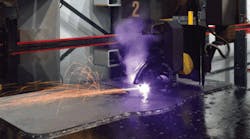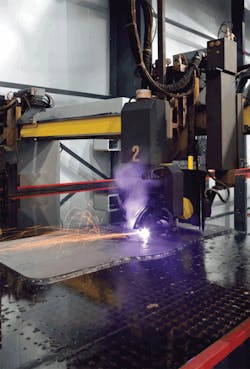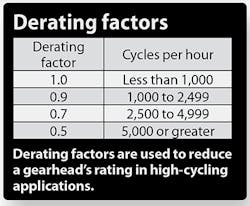Planetary gears — A review of basic design criteria and new options for sizing
Planetary gearheads are high-precision, motion-control devices that generate substantial torque for their size, have high torsional stiffness, and low backlash — making them suited for wide-ranging tasks.
This file type includes high resolution graphics and schematics when applicable.
For instance, specific types of planetary gearheads:
• Run around the clock, seven days a week, for more than 30,000 hr in cartoning applications. The lubricated-for-life gearheads require no maintenance, and high torque-to-size ratios permit compact envelopes and small machine footprints.
• Help attain accuracy within a few ten-thousandths of an inch on plasma-cutting machines, thanks to exceptionally low backlash. Helical crowned gearing provides fast positioning and smooth movement, and sealed gearboxes keep out abrasive dust generated during cutting.
• Limit noise and vibration and meet strict backlash requirements in scanning tables for cardiovascular patients.
• Let food-processing equipment slice meat, bread, and frozen foods at speeds up to four slices/sec. Also available are slim, right-angle designs to fit within the machine envelope and provides quiet, smooth operation.
Planetary basics — ratios, helix angles, axial loads, crowning
A planetary gearhead takes a high-speed, low-torque input, say from an electric motor, then increases torque and reduces speed at the output by the gearhead ratio. This lets motors run at higher, more-efficient rpms in equipment that operates at low speeds. It also reduces inertia reflected back to the motor, increasing stability. And using a planetary gearhead often lets machine builders reduce the size and cost of motion-control hardware.
Planetary units with helical gears, rather than spur gears, have a larger contact ratio. The contact ratio is the number of teeth in mesh at any given moment. While typical spur gearing has a 1.5 contact ratio, helical gearing more than doubles it to 3.3. Benefits of higher contact ratios include:
• 30 to 50% more torque capacity than equivalent spur-type planetary gearing.
• Better load sharing, which increases life.
• Smoother and quieter operation.
• Backlash reduced by as much as 2 arc-min.
The gearhead’s helix angle also has a significant impact on performance because the greater the angle, the more teeth in the mesh at any one time. So increasing the helix angle from the typical 12° up to 15° raises torque capacity by 17 to 20%; and by as much as 40% over straight-cut spur gears. Gears with a 15° helix angle also emit less noise.
Helical-gear teeth generate axial loads on the motor shaft. Gearhead bearings must compensate for these loads. Helical gearheads using ball bearings with little or no axial load capabilities can suffer premature motor-bearing or gear failure. A better approach uses tapered roller bearings, such as in Micron Helical gearheads, to completely compensate for axial loads.
Crowning involves slightly modifying the gear-tooth profile to improve gear mesh alignment, increasing torque capacity and reducing noise. It also improves load distribution on the tooth flank, thereby minimizing high-stress regions that can cause surface pitting.
Some clearance is needed for a planetary gearhead to work effectively. Clearance prevents excessive heat and gear wear and ensures good lubrication. But the small gap between gear teeth leads to lost motion. Real-world gearheads also cannot have infinite torsional stiffness, so windup (flexing) in the gearhead generates additional lost motion.
Understanding how different manufacturers measure backlash is important when choosing a gearhead. There are no strict standards regulating how to measure backlash. This can lead to confusion and misconceptions. Some manufacturers measure and average four or more points on the output shaft to produce a backlash specification. Using this method, a unit with backlash measurements of 4, 6, 10, and 12 arc-min would have a rating of 8 arc-min. Thomson engineers believe backlash should be based on the largest measurement on the output shaft, so the above example would yield a 12-arc-min rating.
In addition, some manufacturers apply 2% of the rated torque to generate backlash ratings, while others apply less. The latter produces lower backlash measurements and doesn’t provide true backlash ratings over the life of a product.
Backlash will increase over time. A planetary gearhead might have 8 arc-min of backlash out of the box but 15 arc-min after six months of use, for example. So how well a planetary gearhead maintains accuracy over its life is an important consideration for most users.
Planetary gearhead sizing and selectionChoosing the right gearhead and accurately sizing it is critical to long and reliable life. As a starting point, designers can approximate required gearhead size from:
Tr = Tm × r × e
where Tr = application torque, Tm = continuous torque, r = ratio, and e = efficiency.
Nonstop, continuous-duty applications do not require derating factors. In those cases, the most common problem is overheating that breaks down the lubricant and causes gear failure. High-performance gearheads, such as Micron EverTrue, are designed to run 24/7, operate under 140°F, and last more than 30,000 hr.
Online selection and sizing tools can save time by letting engineers find and compare planetary gearheads that fit a particular application. (See the accompanying sidebar for more details.)
Troubleshooting planetary gearing
Several problems can crop up in gearheads that aren’t sized and installed properly.
Gearhead noise
Inappropriate input speed, gearhead ratio, output torque, radial and axial loads, and mounting errors can all contribute to gearhead noise. But proper mounting is critical to minimizing noise and maximizing performance. Many gearheads must be mounted to the servomotor while positioned vertically. This lets the motor shaft center the gearhead. After mounting to the motor, the gearhead can be used in any orientation.
Gearhead friction
Too much grease, out-of-tolerance components, and poor gear or bearing quality can cause excessive friction and drag. Look for gearhead manufacturers that test every gearhead for input drag before shipment. Each size and ratio has an acceptable range for drag, and peak levels should be measured in both directions.
Gearhead sealing
For applications that require protection against dust, dirt, and water, be aware that combining an IP65 motor and an IP65 gearhead does not always provide IP65 protection. Look closely at how the interface between the motor and gearhead is sealed. The best approach is to use O-ring seals between all housings for IP65 protection on the full assembly.
A new type of planetary gearhead, the Micron AquaTrue, meets IP67 requirements for food and beverage handling, packaging, and dispensing, thanks to a round stainless-steel housing with no external seams. Such gearheads can withstand caustic cleaning chemicals and high-pressure wash downs, giving engineers the flexibility to mount it without the added cost and complexity of components such as enclosures, shielding, and mechanical transmissions.
Gearhead lubrication
Oil or grease can effectively lubricate planetary gearheads. Grease has the advantage of providing lubrication for the life of the gearhead, eliminating a lot of maintenance. Grease permits mounting in any orientation and eliminates concerns about leakage.
Oil requires maintenance and relubrication, usually every few thousand hours. And leaks are always a concern with oil lubrication. Orientation with oil lubrication is usually restricted, must be specified when ordered, and usually cannot be changed. A common misconception is that oil-filled units always run cooler than grease-lubricated gears. Actually, the sealing required for an oil-filled gearhead often generates more heat than the oil saves.
Online selection and sizing — try out one optionOnline gearhead sizing and selection tools streamline the process of finding the right gearhead for an application. One comprehensive sizing tool is Micron Motioneering. Its Sizing and Selection mode lets users enter application parameters such as speed, output torque, and radial and axial loads, and the tool recommends gearheads that fit the specific application. Here’s a look at how it works. On the first sizing and selection screen, engineers must enter four critical pieces of information: 1. Gearhead type or orientation (in-line or right angle). Right-angle gearheads offer three separate options: standard shaft, dual shaft, and hollow shaft. 2. Application type. Users choose between “Cyclical Operation” and “Continuous Duty.” Any operation that runs in one direction for 4 hr or more without stopping or changing speeds is considered continuous duty. All other applications, including machines that run for more than 4 hr but change direction, are considered cyclical. 3. Backlash requirements fall into three classes: 4. Ratio. At this point, the tool shows users the available ratios for the specified combinations. For example, if one selects an in-line orientation, the 1:1 and 2:1 ratios will be “grayed out” because they are only available in right-angle versions. Next, users have two ways to enter torque and speed requirements. The first option is to enter them as maximum torque and rpm. Either input or output rpm can be entered and the tool will calculate the other. For more-complex applications, users have the option to build a complete motion profile. Each segment of the motion profile requires: speed at the beginning and end of the segment, the duration, and torque during the segment. After specifying these parameters, users can then enter radial or axial loads that may be present. Selecting the motor mount is the final step. Mounts are available from over 300 manufacturers. Users simply select the motor from the pull-down menu and the tool generates the motor-mount part number. Motor dimensions will also be populated on the screen for reference. If the desired motor is not listed, the tool has an option to manually input motor dimensions. Critical dimensions such as shaft diameter and length, bolt circle, and pilot diameter are used to generate the motor-mount kit number the gearhead requires. Users can enter dimensions in English or metric units. After entering all application parameters, the tool summarizes the available gearheads that meet the application criteria, sorted by price from most economical to most expensive. It also lists the safety factor between the required torque and each gearhead’s rated torque. After selecting a product, users can download a 2D or 3D model, request a quote, or save the selection. The “Select Gearhead by Model Number” mode is an option when the required gearhead is already known. It lets users view pricing, catalog specifications, and lead times, and download CAD models. Designers click on the gearhead family and pull down the product type, frame size, ratio, and motor-mount kit. If the motor-mount kit is not known, users can enter the dimensions as explained above. |



